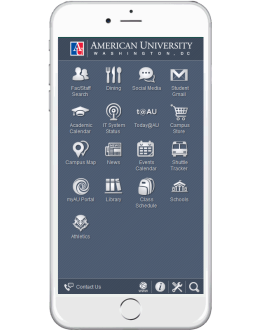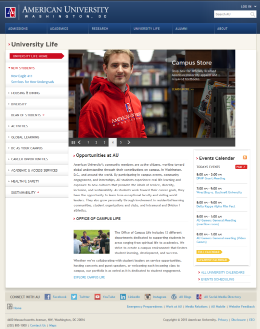
Mobile

Home Page

University Life
How Exceptional Web Experiences Build Community
About American University
American University (AU) is a private liberal arts doctoral institution that was charted by an act of Congress in 1893. Located in Washington D.C., AU's 11,000+ students have twice been recognized as the most politically active in the nation. AU offers students 117 academic programs, including Bachelor's, Master's and Doctoral degrees; as well as certificate and associate degree programs.
The Situation
AU's previous website hadn't been redesigned in a while, and it showed. In their own words, the website suffered from "poor navigation, a heavy use of text, no user experience, poorly maintained links, and a general lack of vibrancy, relevancy, and excitement." In fact, it had the opposite effect than originally intended. When asked about the website, visitors agreed that it was little more than a bulletin board and a phone book, and it "turned them off" presenting AU with a real recruiting challenge. In a nutshell, AU needed to bring its website into the 21st century.
The Challenge
Site visitors have been conditioned to see through marketing messages and tune them out in favor of more authentic, user-driven content. To be truly current, a website must allow an organization's trusted community (whether students, faculty, alumni, constituents, or customers) to help inform site visitors about your business, and what it's like doing business with you. It must engage the people who decide to go or not go to your school, like or dislike your product or service, and recommend it or trash it.
AU recognized that it needed to invest in its relationships with students and faculty, let go of some control, and trust its community to bring a voice of authenticity to its website. The question was: how to do it?
Enter PaperThin
AU's web team knew that it wanted more than standard web 2.0 features. Key to its decision was the ability to augment basic 2.0 applications to meet AU's unique business requirements. CommonSpot provided the web foundation, out-of-the-box features, and a powerful application development framework (ADF) that would make building AU's community website possible. Essential to the project, the ADF enabled AU to develop custom applications, as well as leverage and augment open-source applications developed by PaperThin and its customers.
Community Building
AU carefully chose a number of key features to build that would bring life to the website:
AUPedia—Not Your Average Wiki
AUpedia is one of the many community-driven features of AU's website. A wiki-style informational tool, AUpedia covers all aspects of the university and university life. Whether on study groups, burger joints, or Dungeons & Dragons, AUPedia harvests the collective thoughts, ideas, and opinions of the community giving readers a way to learn about AU's culture from the people who live and breathe it every day.
To build it, Web developers leveraged an open source wiki application already in the CommonSpot ADF, and augmented it through a structured mashup of applications. By mashing up seven applications, AU turned an ordinary wiki into a more powerful form-based application that lets people submit comments, post opinions and photos, and vote on and block content.
AU Profiles
Another interesting feature of AU's website is student, faculty, and staff profiles. Consisting of bios and professional details, AU Profiles help showcase AU's human assets bringing a voice of authenticity and sense of community to the website. To build the Profile application, Web developers leveraged out-of-the box CommonSpot data components (such as simple forms, content objects, and datasheets) to easily build user-driven content applications (such as Scholarly Activities and Affiliations) using CommonSpot's ADF. Then, through a structured mashup, developers added an open source Photo Gallery application developed by PaperThin. Once created, AU easily integrated the new Profile application with its own back-office ERP system.
The result is a form-based application that enables students, faculty and staff to easily create profile pages by leveraging existing ERP data (name, degree, school, office, email, etc.) and enhancing it with their own personal content (such as scholarly and professional activities, campus experiences, club memberships, etc.). AU chose to give readers the ability to flag content deemed inappropriate, thus limiting liability and the risks often associated with unsanctioned, user-driven content.
Multimedia
AU enables media to be presented on virtually any web page or incorporated into applications (such as Profiles or News Stories). This gives AU site visitors the ability to watch a lecture or the University's yearly commencement. AU used CommonSpot's multimedia manager feature to build a multimedia-friendly homepage where all video content is displayed, such as news stories, tutorials, etc.
AU Calendar
AU also implemented CommonSpot's Event Calendar. The Calendar gives the community a glimpse of AU activities—whether occurring that day, next week, or sometime in the future.
Community is Not Just About the Homepage
With all of this authentic, user-generated content being created, AU needed a way to organize and distribute it throughout the site—without having to re-create the content on page after page. Luckily, this area is one of CommonSpot's greatest strengths.
Content Tagging
Whether creating a new success story, news article, or wiki posting, AU content contributors are automatically asked to add keywords or 'tags' (such as Fun, Library, or Athletics) so they can decide how best to organize and classify the content they have created.
Content Organization
Those same content contributors—all members of the AU community—designed and developed an AU-specific taxonomy using CommonSpot's highly praised taxonomy capabilities, giving them complete control over what site visitors see when searching the website. By letting the people that own the taxonomy manage the taxonomy, AU ensures that content is well organized, and provides site visitors with the best search experience possible.
Once created, AU developers leveraged CommonSpot's APIs to incorporate the taxonomy into community applications (such as AUPedia). When a School of International Service student creates an AUPedia article tagged with 'International', for example, that article will also dynamically appear on the student's profile page, the School of International Service homepage, the general AUPedia page, and so on. The result is a more personalized and authentic experience for the site visitor, increased efficiency for content contributors, and better content re-use throughout the website.
Content Delivery
Finally, AU wanted the ability to deliver user-generated content to visitors—when and how they want it. To do this, the development team leveraged CommonSpot's XML framework to easily deliver content beyond the web. For every web page published, CommonSpot builds an XML schema which gives developers the ability to present any type of content (video, podcast, music, etc.) via any content delivery channel (Web, smart phone, MP3, etc.) at any time (on demand or in real time). Syndicating content is even more simple. Content contributors can create RSS feeds in a few clicks of a mouse without the need to write code, alleviating the demand on IT resources and improving efficiency.
Benefits
Students, faculty, and staff now convene on the website to create and share university-driven and authentic, user-generated content which showcases AU to prospective students in a way that gives them a feel for the AU brand—and what it's like to actually be a part of the AU community.
"As with all things on the Internet today, sharing is essential. Whether between students and friends, faculty and staff, or all of our schools and colleges, the new site utilizes CommonSpot to foster content sharing across the AU community," said David Swartz, AU Chief Information Officer. "CommonSpot makes site management, and creating and sharing web content much easier which was essential to our website strategy, and in bringing the entire campus together as a community. Thanks in part to CommonSpot, AU's site has vaulted into a new era."